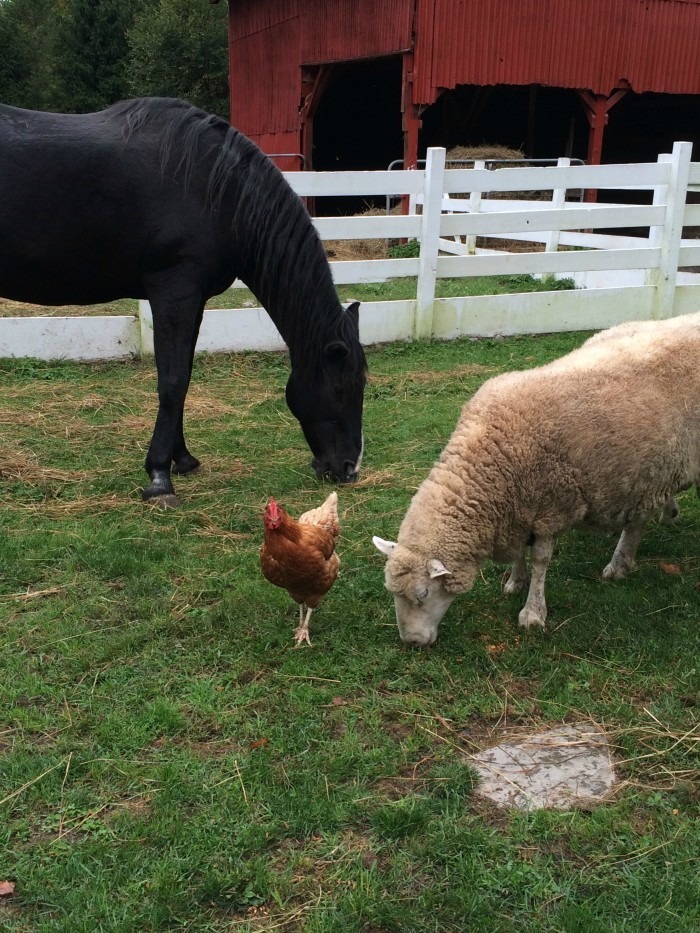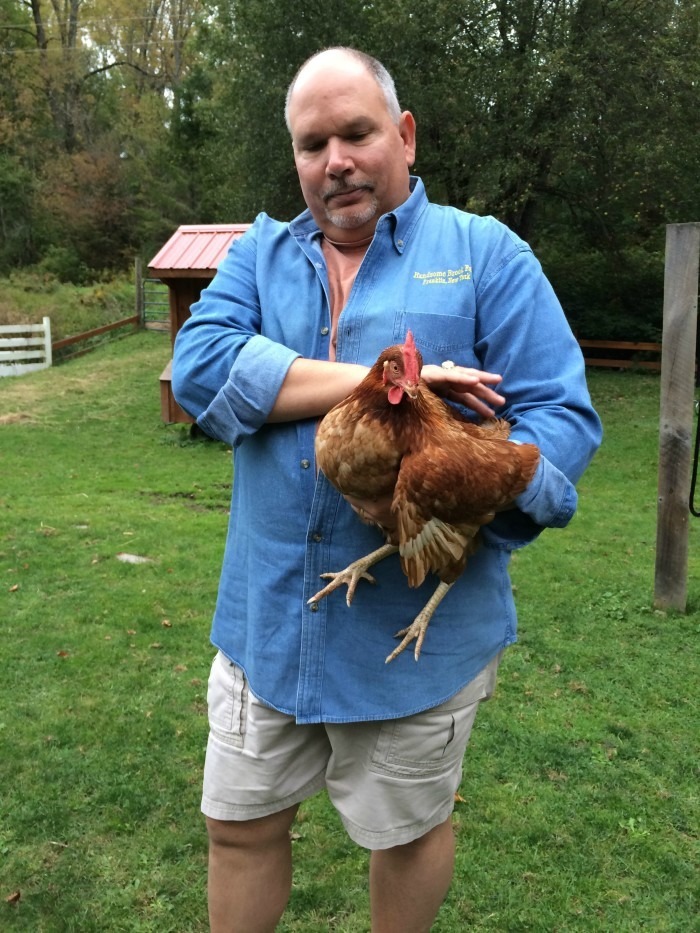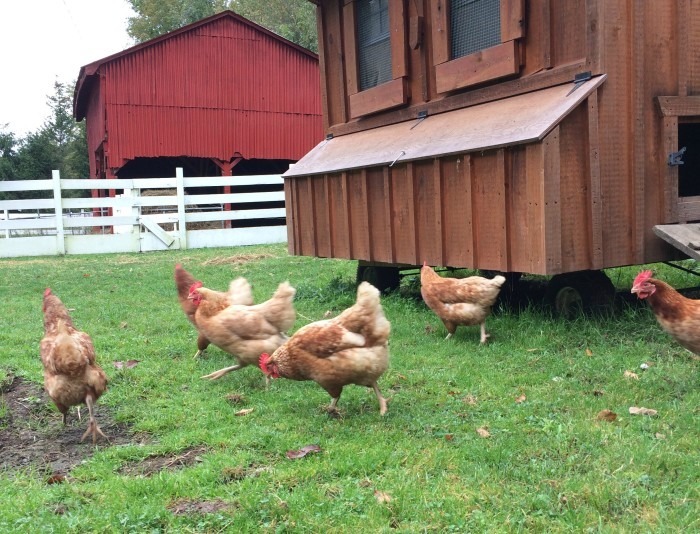Everything You Need To Know About Eggs (And The Lifestyles Of The Chickens Who Lay Them)
It's the first day of fall and the air is refreshingly chilly in Franklin, New York. The grass is lush and green and slightly damp with morning dew. It's feeding time at Handsome Brook Farm, and eight Rhode Island Red chickens slowly bob out of their red coop, where they've spent the previous night. Every day, these chickens walk outside into a wide open field, enclosed by an idyllic white picket fence. The birds share these spacious farm grounds, mingling and chowing down with a horse, two cats, some pigs and a mother-daughter duo of sheep. Treated more like pets than livestock, these chickens don't resent human interaction. In fact, they'll saunter over to you and squat when they wish to be petted. After the morning feeding time, the hens are left to their own devices and are free to roam around, doing as chickens naturally do. When it's time to lay their daily egg, the chicks instinctively return to the coop and do their business. Betsy Babcock, founder and co-CEO of Handsome Brook Farm, says that chickens only lay when they feel safe, which they do in the coop.
If you were to envision the utopian chicken-raising community, it would probably look a lot like this. When you pick up a carton of "cage-free" eggs at the supermarket, this is probably what you imagine their origin story to be. But the fact of the matter is, most "cage-free" chickens don't have it this good. While their situation is substantially better than the cramped confines of the conventional commercial egg facility, even "free-range" chickens don't really get to roam around the range as freely as the privileged cluckers at Handsome Brook Farm. The comparatively liberated lifestyle of Babcock's birds, often called "pasture raised," represents perhaps the highest standard yet for ethical egg production in this country, and the difference just underscores how confusing and misleading modern egg marketing has become.
♦♦♦

In the olden days, buying eggs was a pretty simple task. It was basically a matter of picking a color (brown or white) and size (jumbo, large, medium, e tcetera). Shoppers weren't bombarded withthea plethora of descriptors that you see today. It's getting to the point where consumers know more about eggs than they do a blind date. Or do they?
A recent survey of 700 people found that 98 percent mistakenly thought "free-range" or "free-roaming" meant that the egg-laying chickens in question were actually roaming freely across an open space, like the name suggests. "But the truth is a million miles away from that," says Dan Brooks, creative director for Vital Farms, which conducted the poll. Sure, those so-called free-range chickens aren't confined to a cage, per se, but they're usually still kept inside and not really given much room to roam; it's often less than two square feet per bird, he says.
Like Babcock's Handsome Brook Farm, Brooks's company, headquartered in Austin, Texas, is one of the forerunners of the pasture-raised egg movement. Vital Farms currently works with 90 private family farms from Georgia to California. When Vital Farms started in 2007, this was far from the standard method of raising chickens, Brooks says. And in fact, pasture-raised still isn't formally recognized by the U.S. Department of Agriculture as a category of chicken farming. Nonetheless, Vital Farms proudly emblazons the term on its packaging and further explains, "Our happy hens are humanely raised outdoors."
♦♦♦

Conventional egg farms have long avoided the outdoors, for various reasons. "Egg farmers chose to raise hens indoors several decades ago to provide protection from disease, weather elements and predators, along with allowing for a more controlled diet and hen health monitoring," says Hinda Mitchell of United Egg Producers, a trade group that represents nearly 95 percent of American egg farmers. The industry as a whole, Mitchell says, has made tremendous strides in the way it treats chickens and harvests their eggs. "Technological advances have allowed egg farmers to make great strides in optimal housing, hen health monitoring, diet and overall well-being, all while producing safe, affordable eggs for consumers," she says.
Yet critics say the cramped indoor confines of many chicken farms may actually be contributing to the very problem that prompted chicken farmers to seek better shelter for their chickens in the first place: the spread of disease.
Consider avian flu, which may spread more quickly in close quarters. While the most recent outbreak didn't cause very significant damage to the overall egg supply — production dropped by less than 1 percent to 50 million dozen in 2015, according to a USDA report — it still had a major impact on egg prices. In the New York area, prices soared 104 percent to $2.74 per dozen for grade-A large eggs in the past year. As production is expected to increase to an estimated 7 billion dozen eggs in 2016, the USDA estimates that prices will fall to an average of $1.64 to $1.78. Just to be clear here: We're talking about regular eggs. Customers who opt for higher-quality eggs naturally pay more. Nationally, the current average price for a dozen USDA-certified organic brown eggs falls within the $2.30 to $3.50 range, according to the agency.
Whatever the fluctuations in price and supply, Americans' hunger for eggs remains largely unchanged, according to Mitchell. "Egg demand has remained steady following the recent avian influenza outbreak. According to the CDC, the strains of AI identified in the U.S. presented no risk to human health and could not be transmitted through safely handled and properly cooked eggs," she says.
None of farmers following the pasture-raised model for Vital Farms or Handsome Brook were affected by the flu, their operators say. Handsome Brook's CEO, Bryan Babcock, theorizes that it's because the chickens aren't cooped up in stressful environments, which may encourage stronger immune systems in the birds.
For him, the whole health and safety issue is just one more reason to think seriously about the origins of the eggs you buy and the method of their production.
That's why we've asked Babcock and his counterpart at Vital Farms, Brooks, to give us the straight story on what the words that appear on our egg cartons are really telling us. And, just important, what they're not telling us:
♦♦♦
Caged
Self-explanatory. Chickens are housed indoors in cages with less than a square foot per bird and no access to the outdoors, ever. Their only diet consists of feed. NPR reported in 2013 that an overwhelming 90 percent of eggs that we consume were farmed from caged hens.
Cage-free/Free-roaming
The cages are absent, but the chickens are still indoors with about 1.2 square feet per bird. No outdoor access. Their only diet consists of feed. The packages of Sunshine Farms, a purveyor in the New York, New Jersey and Connecticut region, makes vague reference to "eggs [that] are produced by hens in a carefully managed, cage-free setting with ample space to move freely and engage in natural behaviors."
Organic/Free Range
These chickens are given a little more room (1.2 to 1.75 square feet per bird) than cage-free birds. According to Brooks, "organic" refers to how the land and feed are treated rather than focusing on whether the chickens are treated "humanely." These hens may have some access to outdoor areas.

Pasture-raised
Chickens are given access to 108 square feet of the grassy outdoors per bird. They spend most of their time outside and forage for insects, flowers and grass. The USDA has yet to recognize the term as an official method of farming chickens. According to Brooks, pasture-raised eggs may be higher in protein and vitamins because, as he puts it, "what you get out is what you put in." The Babcocks also point out that the yolks of pasture-raised eggs offer a more vibrant orange tint than the factory-made yellow yolks.
As far as price goes, pasture-raised eggs are vastly more expensive, reaching the $6-7 per dozen price range. Both the Babcocks and Brooks say that there are built-in costs that come with raising laying hens on the pasture — more land comes at a higher price. "It's also a great deal more labor-intensive as the farmer needs to be more hands-on with the flock management than he would be for any sort of confined system," Brooks says. "For those, the bulk of the work is handled by automated systems, whereas our farmers are out in the field every day checking their flocks."
Antibiotic-free
Chickens, like humans, can get sick from time to time. To combat a small illness, medicine, usually in the form of antibiotics, is sometimes the call to action. USDA organic standards require all livestock and their products to be free of antibiotics. However, it's not unheard of if a hen has fallen sick and needs to recover. "We don't market our lack of use of antibiotics, as it's not much of a differentiator, and we'd much rather talk about welfare, space outside, et cetera," Brooks says. "It's a bit like calling your coffee 'mountain grown,' just like everyone else's."
Hormone-free
All USDA-regulated chickens are not given hormones, in other words, all eggs and chickens in the U.S. are hormone-free.
Certified Humane
Defined by the third party Humane Farm Animal Care. As far as the treatment of laying hens go, both free-range and pasture-raised chickens can be emblazoned with the Certified Humane label. In order for free-range eggs to be Certified Humane, the chickens must be allowed daily access to the outdoors (two square feet per bird), weather permitting. As for pasture-raised eggs, these chickens must have outdoor access (2.5 acres per 1,000 birds) all year round. Other standards can be found here. Brooks says that Vital Farms had a hand in creating this definition.
Animal Welfare Approved
Another third-party group that prohibits closed confinement of laying hens. AWA requires at least four square feet per bird of outdoor foraging space and 1.8 square feet of indoor space.
Non-GMO
This refers to the feed given to the hens and not the chickens themselves. It ensures that it doesn't contain any genetically modified organisms.
Organic
This standard is set by the USDA. In order for eggs to be organic, the chickens are required to be living free range "with minimum indoor and outdoor space, i.e., it may be a covered porch," Brooks says. The USDA's official site does not specifically outline what living conditions for organic chickens are.
Vegetarian diet
According to Betsy Babcock, chickens are natural omnivores and will eat plants and insects. "The chicken companies that market themselves as being 'vegetarian-fed' are clearly not letting their hens outdoors or eating an omnivore diet that is best for chicken health," she says.
Brooks says the term is misleading. "We do say that we provide [the hens] a vegetarian feed, which is to distinguish from any feed that may contain animal by-products, but they enjoy a mixed diet out on the pastures," Brooks says. "We've had consumers tell us that they don't appreciate it when companies make a big deal about 'vegetarian-fed,' as they know that that is not necessarily a good thing."
Omega-3
The healthy fatty acid that is most often found in fish and nuts can also be sourced from eggs, depending on the chickens' diet. Organic Valley advertises that its omega-3 eggs are a source of the fatty acid because its chickens are fed a diet high in flaxseed, another source of omega 3. A 2010 study performed by Penn State University found that pasture-raised eggs were higher in omega-3 fatty acids and vitamins A and E than non-pasture-raised eggs due to the variety in their diet, which consisted of grasses and insects that were foraged. These eggs were compared to those of chickens who were fed commercial hen mash.

